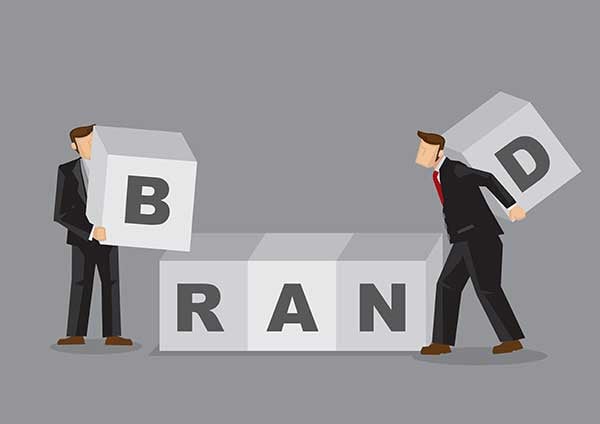
Brand building can be one of the most significant things you can do for your new or existing business. A solid brand building process can transform your business from a small player into a successful competitor.
Your customers will develop a deeper level of trust for your brand and be more likely to purchase what you are selling. It allows you to develop a consistent message and visual identity to reinforce your mission – that’s why it is important to integrate your brand into every aspect of the customer’s experience: from your shop/office front to your website, to your personal interactions.
Your brand is so much more than your logo. Although your logo is the visual representation, your brand also provides the building blocks for your customer experiences, industry position and much more. A successful brand is a critical foundation for your business.
Having a brand that is on point for your target market helps build a strong base of loyal customers who will return to your product or service, even in challenging economic times. As a small business, you may be competing against big brands with devoted customers and unlimited marketing budgets. That’s why you have to find ways to differentiate, with a solid brand building process of your own.
Although it can be tempting to emulate success stories of big international brands, it’s a trap for smaller NZ based businesses. Instead of trying to copycat what the big brands are doing, celebrate what makes your business different.
Although big brands have big budgets to spend on marketing, local businesses are more responsive and agile when it comes to addressing consumers’ needs and wants as they arise. Take advantage of your home grown appeal. With the ongoing trend towards locally made, artisan products etc, people are being drawn to small independent operators with innovative interesting offers.
what is a brand?
Simply put, your brand is defined by a customer’s overall perception of your business. A successful brand has to be consistent in communication and experience, across many applications:
- Physical environment (shopfront or office)
- Print, signage, packaging
- Website, social media and online advertising
- Sales & customer service
Building a brand is definitely a process. However, the ongoing effort will result in establishing long-term relationships with your customers. This can lead to a steady increase in sales, more projects, word-of-mouth referrals, and advocacy for your products or services.
building blocks towards your brand
- Determine your brand’s target audience.
The foundation for building your brand, is to determine the target audience that you’ll be focusing on. You can’t be everything to everyone, right?
Solidify a picture of your consumers, then learn how to create a brand identity that they can understand and relate to. You may come to realize that the competitive advantage when branding your business is to narrow your audience focus. This can help ensure that your brand message comes across crystal clear.
Identifying the target audience for your services or products is an exercise that will affect and benefit all areas of your brand building process, particularly marketing efforts. You want the right person consuming your content, clicking on your ads, opting into your email list, etc.
Determining the right target audience will also support your overall digital brand strategy for marketing. So it is definitely an important first step.
- Define a brand mission statement.
Have you thought about your mission? If you haven’t – read our earlier blog about Defining your Vison, Mission and Position.
In essence, you’ll have to craft a clear expression of what your company is most passionate about. Before you can build a brand that your target audience trusts, you need to know what value your business provides.
The mission statement basically defines a purpose for existing. It will inform every other aspect of your brand building strategies. Everything from your logo to your tagline, voice, message, and personality should reflect that mission.
Start small with your own branding, and remember to focus on your target niche audience first. With time, your brand loyalty may grow enough to expand your reach.
Take a step back for minute…check on whether you’re really committed to Step 1 of determining who your exact consumer is. It’s one of the most important branding process steps of them all.
- Research brands within your industry niche.
You should never imitate exactly what the big brands are doing in your industry. But, you should be aware of what they do well (or where they fail).
The goal is to differentiate from the competition, to convince a customer to purchase from you over them! We’re always thinking about how to make a brand stand out.
Don’t skip this step in the brand building process.
Research your main competitors or benchmark brands. Study how they have effectively, and ineffectively gone about building a brand name. Create a list of competitor brands, then answer these fundamental questions.
- Is the competitor consistent with messaging and visual identity across channels?
- What is the quality of the competitor’s products or services?
- Does the competitor have customer reviews you can read, or social mentions about them?
- In what ways does the competitor market their business, both online and offline?
- Outline the key qualities and benefits your brand offers.
There will always be brands with bigger budgets and more resources to command their industry. But your products, services, and benefits belong solely to you.
You have to delve down deep and figure out what you offer, that no one else is offering. Focus on the qualities and benefits that make your company branding unique. Assuming you know exactly who your target audience is (Step 1), give them a reason to choose your brand over another.
It’s important to note that this is not just a list of the features your product or services offer to the customer or client. Think about how you provide value that will improve your customers’ lives i.e benefits they will experience.
Here are a few examples:
- More authentic and transparent customer service making it easy to deal with your business
- A better way to support productivity that makes your service delivery efficient for customers
-Reducing costs with a more affordable option to save customers’ money
-Saving time on daily tasks that saves customers’ time
- Create a brand logo & tagline.
When you think about how to build a brand, visuals probably come to mind first. This step may be the one where you need help with execution.
The most exciting (and arguably the most important piece) of the brand building process, is to create a brand logo and tagline for your company.
This logo will appear on everything that relates to your business. It will become your identity, calling card, and the visual recognition of your promise. So be willing to invest the time and money by creating something exceptional to reinforce the visual identity for your business.
Maintaining your brand
- Get Your Team on the Same Page
Ensuring that your employees have bought in to your brand story is critical. As far as your customers are concerned, they are not a representation of your brand, they ARE your brand. Make sure you ask employees for feedback. As the ones who have the most direct contact with customers, they may be able to provide valuable insights to help you on your way to becoming the next iconic NZ brand.
- Share Your Expertise
Work out your areas of expertise and share your knowledge through blogs, social media, newsletters, speaking events and any other channel you can use to get your voice out there. Today there are so many communication channels available, make the most of them and position yourself as an industry expert.
- Reward Your Fans
People love to feel recognised and valued. Make sure you know who your most valuable and loyal customers are and reward them with exclusive access to events and deals, advance notice of new releases and special offers. Treat them well and these loyal customers can turn out to be some of your strongest human billboards.
- Be Responsive
Monitor your business’s social media and respond to any customer queries or feedback immediately. The same goes for any communication received via phone, email or your website. Deal with any problems immediately. Be honest, acknowledge the problem, let customers know what went wrong and what you are doing to fix it. Unresolved issues can lead to your brand losing value with your customers so don’t sit around hoping the problem will go away – fix it today.
Sources used:
 0800 543 543
0800 543 543






